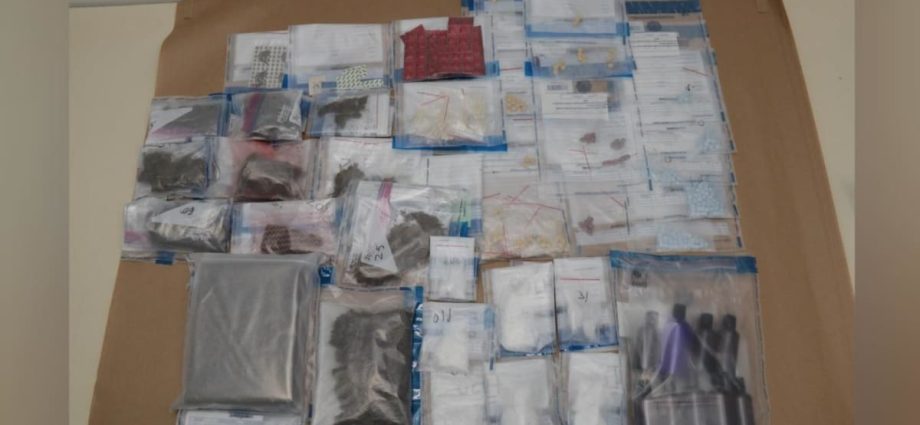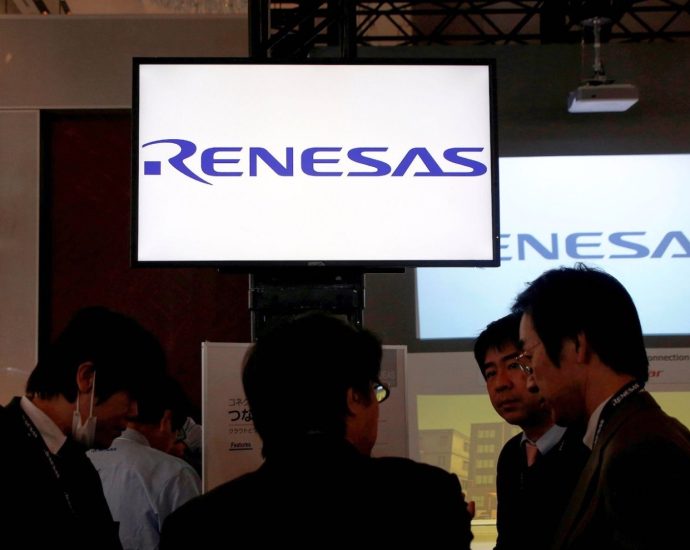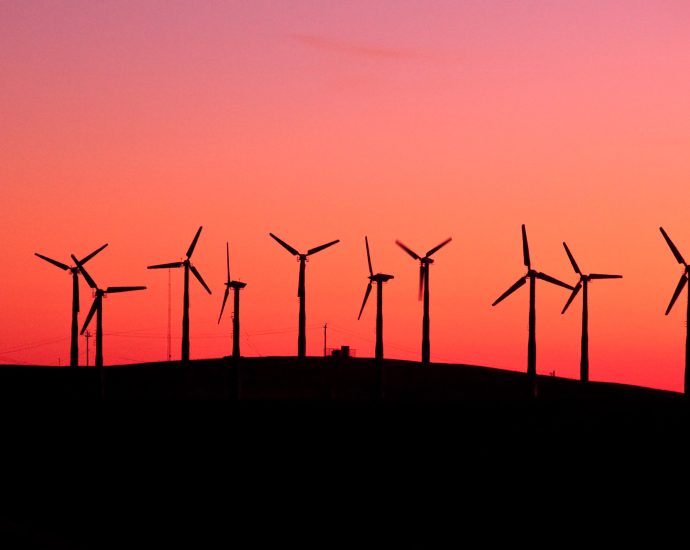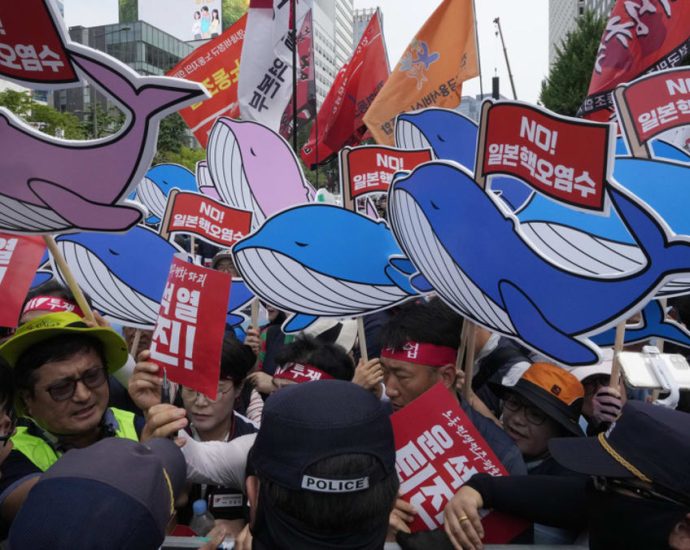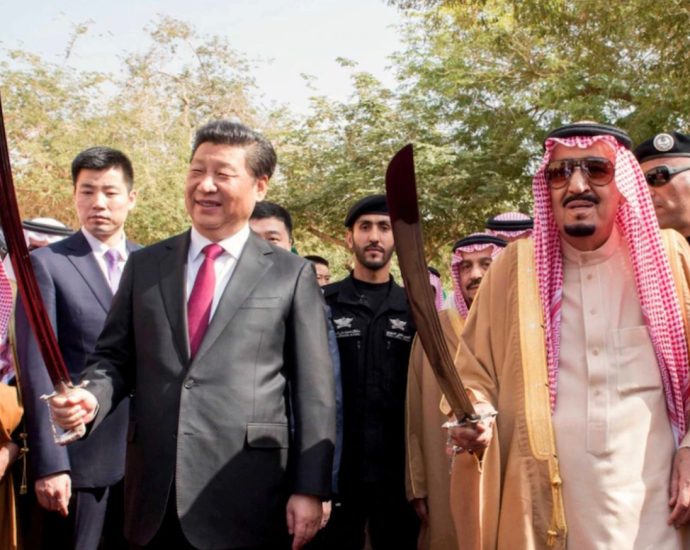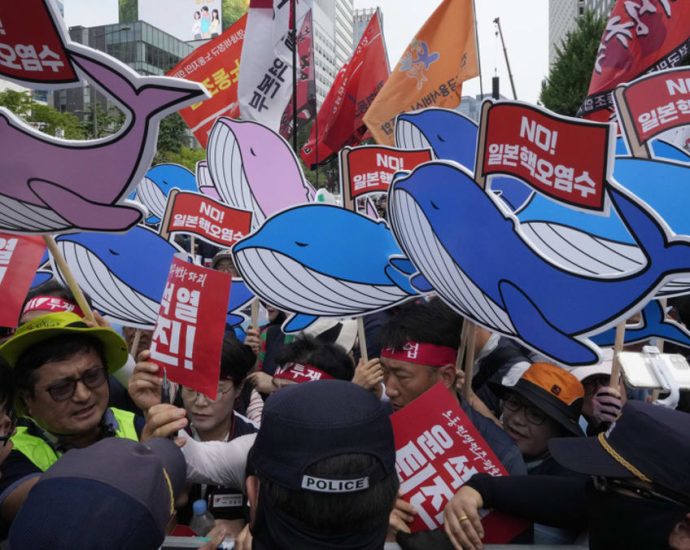Man charged after drugs worth S$173,000 seized by CNB; police officer injured during arrest

SINGAPORE: A 28-year-old Singaporean man was arrested on Wednesday (Jul 5) in Bishan for suspected drug-related offences, with an estimated S$173,000 (US$127,955) worth of drugs seized during the search.
A police officer also sustained minor injuries during the arrest, said the police and the Central Narcotics Bureau (CNB) in a press release on Friday.
At about 6.40pm on Jul 5, the police responded to a call for assistance at a residential unit along Jalan Binchang in Bishan.
“The man put up a violent struggle to resist arrest, and necessary force was used to subdue him,” said the authorities.
About 450g of Ice, 2,229g of cannabis, 71g of capsules containing crystalline-like substances, 258g of Ecstasy tablets, 81 Erimin-5 tablets, 89 lysergic acid diethylamide (LSD) stamps, as well as drug paraphernalia were seized after the police conducted a search in the unit.
CNB officers were later called to the scene and the case was referred to them for further investigations.
Wolfspeed-Renesas deal heralds the future of power chips
TOKYO – Renesas, Japan’s top maker of automotive chips, has reached a 10-year supply agreement with America’s Wolfspeed, the world’s leading producer of the silicon carbide wafers used to make power semiconductors.
Both companies have ambitious plans to meet rapidly growing demand for electric vehicles (EVs) and charging infrastructure, renewable energy generation and storage, and industrial motor control and other power management.
A US$2 billion deposit from Renesas will support Wolfspeed’s capacity expansion plans in the state of North Carolina. Meanwhile, a guaranteed supply of Wolfspeed-made wafers will support Renesas’ power device manufacturing in Japan. The agreement was signed at Renesas’ headquarters in Tokyo on July 5.
Wolfspeed CEO Gregg Lowe said that “With the steepening demand for silicon carbide across the automotive, industrial and energy sectors, it’s critically important we have best-in-class power semiconductor customers like Renesas to help lead the global transition from silicon to silicon carbide.”
Renesas CEO Hidetoshi Shibata said, “The wafer supply agreement with Wolfspeed will provide Renesas with a stable, long-term supply base of high-quality silicon carbide wafers. This empowers Renesas to scale our power semiconductor offerings to better serve customers’ vast array of applications. We are now poised to elevate ourselves as a key player in the accelerating silicon carbide market.”
Compared with silicon, silicon carbide offers greater energy efficiency and reliability through resistance to higher voltages, tolerance of a wider range of temperatures and vibration, and longer device lifetimes. As production volumes rise and prices fall, the use of silicon carbide should also lead to lower power management system costs.
Wolfspeed, formerly known as Cree, has been making silicon carbide wafers and power devices for more than 35 years. It also produces radio frequency devices and gallium nitride materials. Its products are used in communications infrastructure, satellite communications, aerospace and defense.

In April 2022, Wolfspeed opened the world’s first 200mm (8-inch) silicon carbide wafer factory in New York. In September 2022, the company announced plans to build a big new silicon carbide materials facility in North Carolina that aims to boost production by more than 10 times by 2030.
This is in line with market research organizations’ forecasts of the silicon carbide market’s potential.
Phase one of the North Carolina facility, estimated at $1.3 billion is scheduled for completion in 2024. Industry sources estimate Wolfspeed’s share of the silicon carbide wafer market at more than 60%.
200mm wafers are 1.7x larger than the 150mm (6-inch) wafers that were previously the silicon carbide industry standard. Larger wafers mean more chips per wafer and a lower cost per chip. Wolfspeed will supply Renesas first with 150mm wafers and then with 200mm wafers as its production capacity increases.
Renesas manufactures semiconductor products for automotive, industrial, infrastructure, internet of things (IoT) and other applications. It is a world leader in microcontrollers for the auto industry.
The Japanese company also possesses embedded processing, analog, power management, radio frequency, SoC (system-on-chip) and other semiconductor technologies.
In May 2022, Renesas announced plans to refurbish and reopen its old Kofu factory and start making power semiconductors on 300-mm (12-inch) silicon wafers there in 2024.
In 2025, the company plans to start mass production of silicon carbide devices with wafers procured from Wolfspeed at its factory in Takasaki. At present, the Takasaki factory makes silicon power devices.
Renesas has doubled its revenues over the past five years, with growth in the auto, industrial, infrastructure and IoT markets accelerated by six acquisitions, namely:
- Integrated Device Technology of the US, which makes mixed-signal semiconductors used in telecom, computing and consumer electronics
- Dialog Semiconductor of the UK, which produces power management, Wi-Fi, Bluetooth and industrial computing chips
- Celeno Communications of Israel, which specializes in WiFi chipsets and software
- Reality Analytics of the US, which is involved in software combining signal processing, machine learning and anomaly detection on Renesas MCU/MPU cores
- Steradian Semiconductors of India, which is involved in 4D imaging radar for object recognition and power efficiency in Renesas Advanced Driver Assistance System SoCs
- Panthropics of Austria, which specializes in Near Field Communications semiconductor design
Leveraging these strategic acquisitions, Renesas now plans to become a big producer of both silicon and silicon carbide power devices.
Their synergy with the company’s existing products and strong market demand point toward substantial growth ahead. Investors certainly think so: Renesas’ share price is up 2.3 times so far this year.
In July 2022, less than a month before President Joe Biden signed the CHIPS Act, CEO Shibata told the press that Renesas does not plan to make semiconductors in the US.
“When it comes to front-end production [the manufacture of chips on wafers],” he said, “I don’t necessarily believe there are good supplies of ingredients in geographies like Europe or the US”
By “ingredients,” he seems to have meant high costs and shortage of skilled labor – the same issues chip-making giant TSMC has been complaining about in Arizona.

Buying silicon carbide wafers from Wolfspeed, on the other hand, apparently makes more commercial sense to Renesas than sourcing them from smaller and less experienced manufacturers in Japan.
These companies, including Showa Denko, Central Glass, Mipox and Oxide, are part of a silicon-carbide development project run by Japan’s New Energy and Industrial Technology Development Organization (NEDO). Despite handsome government support, they did not win the Renesas contract.
Rohm, one of Japan’s leading makers of power devices, relies on SiCrystal, a German company it acquired in 2010, for its silicon carbide wafers. SiCrystal also sells wafers to other companies.
On June 29, Rohm signed a long-term agreement to supply silicon carbide power semiconductors to Vitesco Technologies, a German maker of electrified vehicle drive systems. This deal, too, appears to be economic rather than political.
Follow this writer on Twitter: @ScottFo83517667
Court of Appeal finds Sylvia Lim, Low Thia Khiang liable for negligence in AHTC payments process, but not Pritam Singh
SINGAPORE: The Court of Appeal has found Workers’ Party leader Sylvia Lim and former party secretary-general Low Thia Khiang liable for negligence in the Aljunied-Hougang Town Council (AHTC) payments process, but cleared WP chief Pritam Singh over this issue. This is the latest update on a long-running civil trial overContinue Reading
Rahul Gandhi: Gujarat High Court dismisses Congress leader’s appeal in defamation case
 Getty Images
Getty ImagesThe Gujarat high court has dismissed Indian opposition leader Rahul Gandhi’s appeal seeking a stay on his conviction in a criminal defamation case.
Mr Gandhi was sentenced to two years in jail in March for his 2019 comments about Prime Minister Narendra Modi’s surname at an election rally.
He was disqualified as an MP following his sentencing.
But Mr Gandhi will not be arrested until he has exhausted all legal appeals as his arrest was put on hold.
Friday’s decision is being seen as a setback for the Congress leader as it means he cannot contest national elections due next year. He is expected to appeal in the Supreme Court.
While dismissing his appeal, the Gujarat high court said Mr Gandhi’s conviction was “just and proper”.
Mr Gandhi lost his seat in parliament a day after his conviction on 23 March due to a Supreme Court order which says that a lawmaker convicted in a crime and sentenced to two or more years in jail is disqualified with immediate effect.
The party criticised Mr Gandhi’s conviction and accused the governing Bharatiya Janata Party (BJP) of political vendetta. The BJP denied this, saying that due judicial process was followed in the case.
The defamation case against Mr Gandhi, brought by BJP lawmaker Purnesh Modi, revolved around comments Mr Gandhi made in Karnataka state in 2019 during an election rally. “Why do all these thieves have Modi as their surname? Nirav Modi, Lalit Modi, Narendra Modi,” he said.
Nirav Modi is a fugitive Indian diamond tycoon while Lalit Modi is a former chief of the Indian Premier League who has been banned for life by the country’s cricket board.
In his complaint, Purnesh Modi alleged that the comments had defamed the entire Modi community. However, Mr Gandhi said that he made the comment to highlight corruption and it was not directed against any community.
A lower court had granted Mr Gandhi bail to appeal against his conviction, but it’s the stay or suspension of his conviction that’s crucial to reinstating him as an MP.
BBC News India is now on YouTube. Click here to subscribe and watch our documentaries, explainers and features.

Read more India stories from the BBC:

Related Topics
Taylor Swift: What Asian fans did for her concert tickets
 EPA
EPAMillions of Taylor Swift’s South East Asian fans are competing for about 330,000 seats that went on sale on Friday for her only stop in the region.
The pop star’s Eras Tour includes six shows in Singapore in March 2024.
Devoted fans have skipped work, charged up their devices and joined long queues for the coveted tickets.
The tense situation which is unfolding both on and offline, will end with either Bad Blood or with some seeing their Wildest Dreams come true.
Swift is also performing in Japan and Australia, but nowhere else in East or South East Asia, where her fans or “Swifties” are legion. Singapore, the Indonesian capital Jakarta and the Philippines’ most densely packed city, Quezon, are among the world’s top locations for streaming Swift’s songs, according to Spotify.
So for fans in this corner of Asia, Singapore which is closer, offers visa-free or visa-on-arrival and plenty of cheap flight options, is an easy pick. The country has long been a popular stop for big music acts because of its impressive public transport and infrastructure – Coldplay is performing at the expansive National Stadium a month before Swift.
This is Swift’s first post-pandemic concert outing. She has not toured since her 2019 Lover album and there’s a wealth of material from three records she has released since then – Evermore, Folklore and Midnights.
Lines are already snaking outside Singapore post offices, where fans can buy tickets offline. Given the demand, the daily Straits Times suggested four sleepy spots on the island’s outskirts where the chances of getting tickets could be higher.
“It’s Taylor Swift, I just have to see her,” says Joan Ng, who along with a group of her 15-year-old friends has camped out overnight at the post office in a Singapore mall to buy tickets. The girls say Joan is the biggest Swiftie among them.
They couldn’t skip school during the pre-sale, so they convinced their parents to lend them their credit cards and allow them to stay at the mall. They hopped from one shop to another to stay inside and then took turns napping at Haidilao, a popular hot pot chain, until daybreak. They shared a bowl of soup for dinner.

“She’s the best music artist of all time,” says Levincia Ong who considers Swift’s country album about teenage love and heartbreak, Fearless, to be the soundtrack to her life.Sajani Rajikumar says they have to get the tickets because they have “spent so much effort being here”. But the line is moving slowly because the system keeps crashing.
At the front, 18-year-old friends Kean Teo and Kenneth Lim were the first to get hold of the tickets. “We feel very lucky. It was a long wait,” says Kenneth, grinning. They had wandered around the building for 31 hours, also taking turns to sleep at Haidilao.
It has been no less harrowing online. A competitive pre-sale on Wednesday, which was exclusive to cardholders of Singapore’s United Overseas Bank (UOB), offered a preview of the hunger games that could unfold later in the week. Over a million fans joined the virtual line and UOB reported a surge in credit and debit card applications in the weeks leading up to the pre-sale.
The excruciating wait played out on WhatsApp chats, TikTok and Twitter as people swapped strategies and tips – these included logging on ahead of time, perhaps even a day before, unlockng devices, and turning off sleep mode. Groups of friends, meanwhile, plotted to aim for different dates and seats so they so they could maximise their chances. Some even took a day off work, or cleared their schedule for the entire day. Others queued up using multiple devices and waited to see which one of them – laptop, tablet or mobile phone – would get to the virtual ticket counter first.
“Oh my god, this pre-sale was so exhausting,” says Endro who lives in Jakarta. The 31-year-old did not wish to share his last name. He was glued to his devices all day, but his attempt ended in failure and a dispiriting queue number: 493,901.
“For now, I think I will still try, but I have to be realistic… I don’t want to make myself more miserable by hoping too much.”
Agniya Kh, a 29-year-old Jakartan who snagged tickets in the pre-sale, says it reminded her of a hit from Swift’s most recent album, Midnights: Great War. “”This is definitely the Great War for Swifties in [South East Asia]. Can we just ask for more dates, please?”
She used both her laptop, which put her 22,987 in the queue, and her smartphone, which placed her much further behind at 896,813.

The 29-year-old who works in a start-up in Jakarta will be flying in to Singapore to watch Swift. She missed the chance in 2015, when Swift performed her album, 1989. On a tight student budget, Agniya couldn’t make it then. This time, she’s elated to be there: “It will be an indescribable feeling to hear live the songs that I listen to everyday.”
But she will be back on the ticketing portals on Friday to help fellow Swifties buy tickets in the general sale.
“This tour is a must-see for any Swiftie because it’s the ultimate synthesis of her 17-year career,” says Wincy Reyes from Philippines’ Quezon city.
His strategy included borrowing a Singaporean friend’s UOB card, and also monitoring plane ticket prices from Manila to Sydney and Tokyo in case they needed a backup plan. But a sudden work trip took him to Australia, where he got tickets to Swift’s Sydney show, saving him and his friends from the Singapore rush.
“It felt surreal,” he says. “I was screaming and running around after, not caring much because I’m in a foreign country. LOL.”
Endro says he might head to Singapore ticketless on the days the concert is happening. He says he will listen from outside, much like what some US fans have been doing.
“It’s just my wild plan, [I am] not really into it because I still wish I could get tickets from the general sale or maybe some fan that couldn’t come to the show.”
Meanwhile, millions of Chinese fans are heartbroken that the pop star, who has performed there three times before, the last time being 2019, is not making a stop there on her Eras Tour.
On Weibo, China’s Twitter-like platform, where Swift is followed by more than 10 million fans, the most popular comments echoed some version of “China plz!!!”
One much-liked comment read: “Tens of millions of people are fighting for 10 shows in Asia. Add more in Asia! Add China!”
Related Topics
-
-
25 February

-
-
-
1 December 2022

-
AI will continue to create smarter robots

Job loss caused by new technology is a constant in the history of industrial development. Innovations make obsolete some industrial activities while creating new ones – creating winners and losers.
Such changes are unpopular among those affected. Some examples of resistance were violent. A famous example is the resistance to new textile technology in Great Britain in the early 19th century that eliminated the jobs of some of the most skilled textile workers, which led the destruction of new equipment – to no lasting effect, as mechanization continued.
Machines continue to replace workers and at the same time create new, more sophisticated jobs that add more value than the jobs replaced by machines. And automation continues because it drives economic value creation that benefits society at large. A visit to a modern production plant will quickly show how robots have replaced manual workers with people operating computers.
Enabling these transformations are, of course, computers and new communications systems. Computers and new software have been creating and destroying jobs for many years. But new technology, with highly visible benefits, has been taken for granted as an obvious “good thing.”
But now we have reached a new stage, with dramatic advances in AI (artificial intelligence) technology, as demonstrated by ChatGPT, software recently released by Microsoft. What caught public attention is that the technology demonstrates the software’s ability to produce remarkable documents and respond well to questions based on massive storage of data.
‘Thinking’ robots?
Such results look like robots with human characteristics. This drew enormous public attention as well as fear, leading to demands for government controls placed on the AI technology to limit its “dangerous” applications.
Are robots finally “thinking like humans?” Such results immediately set off predictions of the massive replacement of lawyers and many other workers. An analysis by Asia Times’ David Goldman, “The great chatbot bubble,” suggests that the near-term potential of the technology has been overstated.
We now have smarter robots, but they have been getting smarter for a long time.
Robots are not humans. Human intelligence is the combination of many skills. Acquiring and applying knowledge and reasoning to solve problems are not quantified is a key human characteristic. The ability to discover related connections is a source of invention. Above all, human intelligence can deal with solving problems where related information is ambiguous.
The history of industrial development is that employment patterns adapt to enable ever more sophisticated functions. As machines replace humans, new jobs emerge, enabling new products and services hitherto impractical. Just look at the low US unemployment in recent years in the face of growing economic sophistication.
Ultimately, robots are machines that perform functions that they are trained to do. The software cannot reliably quantify uncertainty, and human involvement is needed.
For example, in medical applications where computers are tasked to read images such as X-rays, radiologists are needed to view and judge the importance of certain features in correlation with other features. The possibilities are infinite; hence human judgment and experience are essential.
Robots will remain our tools, and any ideas for controlling AI technology through regulations will remain speculative.
Henry Kressel is a technologist, inventor, author, and long-term private equity investor.
Opinion: E.U. tilting at windmills with new Deforestation Regulation
The E.U.’s Regulation on deforestation-free products is starting to play out like Don Quixote.
Much as the protagonist in the 17th century Spanish epic, the E.U. sees itself as a knight seeking to do good – and, in the process, finding enemies where there may be none. On a quest to limit the ecological impacts of E.U. commodities imports, this regulation is tilting at windmills, attacking illusionary foes.
The windmills right now in the E.U.’s case are countries that export commodities such as timber, palm oil, coffee, cocoa and rubber to Europe, which has long called for greater monitoring of the environmental impact of this kind of trade.
At its core, the new legislation, which entered into force on 29 June, holds that firms importing goods into Europe need to prove they did not originate from land cleared since 31 December, 2020. Companies must also confirm imported commodities are produced in compliance with the “relevant laws” of their country of origin.
Trade partners such as Indonesia and Malaysia, which together produce about 83% of the world’s palm oil supply, share many of the ecological goals and declarations as stated by E.U. lawmakers.
But in May, the two sent a mission to Brussels arguing the Deforestation Regulation discriminated against their palm-oil-dependent economies and would harm their agricultural sectors. Both have long perceived the E.U. as taking unfair advantage of palm oil to stifle competition against its own oilseed crops, particularly rapeseed, and view the new regulation as yet another act of economic protectionism pressed under the cover of environmental concern.
In 2018, when Europe banned palm oil from biofuel use under the E.U. Renewable Energy Directive (RED), palm-oil-producing states lobbed accusations of ‘crop apartheid’. They soon appeared vindicated when the International Union for Conservation of Nature (IUCN) published a report acknowledging the land efficiency and productivity of palm oil as a crop – as compared to other seed-oils, including those preferred by Europe – meant there were “no easy solutions” to regulating its role in deforestation.
“Palm oil is decimating South East Asia’s rich diversity of species as it eats into swathes of tropical forest,” said Erik Meijaard, the report’s lead author and then-chair of IUCN’s Oil Palm Task Force. “But if it is replaced by much larger areas of rapeseed, soy or sunflower fields, different natural ecosystems and species may suffer. To put a stop to the destruction we must work towards deforestation-free palm oil, and make sure all attempts to limit palm oil use are informed by solid scientific understanding of the consequences.”
The new Deforestation Regulation are unconvincing on that last point, which should concern conservation-minded readers. To their credit, the E.U. Commission has set up a Joint Task Force with Malaysia and Indonesia to address issues related to palm oil smallholders and other challenges of the regulation’s implementation.
But they’ll have to work quickly on that front. European importers now have 18 months or less to find a way to comply with this new legislation. The only sure way for them to meet this target is if the E.U. acknowledges certification programs for targeted commodities. For the palm oil industries, national programmes such as the Malaysia Sustainable Palm Oil (MSPO) scheme and its Indonesian counterpart (ISPO), must be counted in as credible enablers towards meeting the regulatory deadline.
Though these domestic sustainability schemes are not perfect programmes, they have greatly developed in recent years and have made tangible advancements in reigning in deforestation.
This would seem to be evidenced by the World Resources Institute (WRI) in its latest report on Global Forest Review. The report found that Indonesia and Malaysia marked near-record low levels of deforestation even as tropical forest loss elsewhere worsened in 2022, making specific mention of the MSPO and other domestic, industry-focused measures of recent years.
This kind of data will be instrumental in the E.U.-Malaysia-Indonesia task force’s work to resolve the palm oil problem, which stands in the way of trade deals between the three entities. If the E.U. refuses to acknowledge the ongoing efforts to make the industry more sustainable, it will effectively discourage its further advancement – instead incentivising producers to turn their backs on the European market as they seek less discriminating trade partners in Africa and Asia.
Major exporting countries such as Brazil, the world’s biggest exporter of soy, have chosen to brush off the demands of the new E.U. regulation by quoting national laws as being compliant with global commitments. It is worth noting at this point that the expansion of soy plantations is the second-largest direct driver of deforestation and conversion, after the expansion of pasture for cattle farming and land speculation.
Brazil’s confidence in maintaining its exports is bolstered by China and – as a further disregard of what the E.U. is demanding in terms of deforestation – these two countries have made a joint commitment to end illegal deforestation. This is very different from what the E.U. is demanding, which is that all imported commodities must be free of deforestation, whether legal or illegal.
Back in Southeast Asia, E.U. Member of Parliament Bernd Lange has appealed for understanding of the E.U.’s position in an opinion published in The Jakarta Post. The European Parliament in ASEAN tweeted in support, urging a constructive and result-oriented negotiation with Indonesia towards a trade agreement.
Such negotiations are in everybody’s best interest, especially when compared to a more Quixotic approach. But the European Parliament should note that consensus on the regulation can only be reached when the E.U. stops making one-sided demands on its trade partners and engages with them as part of the solution to greener supply chains – not as the problem.
Robert Hii is an independent industry monitor whose focus is on the sustainability of palm oil. He was born in Sarawak, Malaysian Borneo, and later moved to Canada. He now runs CSPO Watch, a platform that monitors the palm oil industry with a focus on sustainability.
South Korean opposition step up pressure on government to condemn Japanâs Fukushima water release

SEAFOOD VENDORS FEEL HELPLESS
Meanwhile, many vendors at Noryangjin fish market, the largest fisheries market in Seoul, told CNA that they feel helpless, even as the debate over Japan’s plan to release treated radioactive water into the ocean rages on.
“What can we do?” said one vendor. “We don’t have the power to stop it, and so I just hope the discharge will have a very limited impact.”
Many South Korean consumers are worried that the country’s sea products could be contaminated by wastewater released into the sea by Japan.
“Of course I am worried about the safety of (the products) before and after the release,” said a resident.
“Because this is related to what I consume, and since I have children, I am worried.”
Sino-Saudi economic engagement deepens

If evidence were needed of just how rapidly economic ties are growing between China and Saudi Arabia, you only have to look at two events that took place last month.
The first was the China-Arab Business Conference in Riyadh. More than 30 agreements worth at least US$10 billion were reached during the gathering.
The second was the World Economic Forum event held last week in the Chinese city of Tianjin, known as the “Summer Davos.” The level of importance Saudi Arabia placed on the event was reflected by the unprecedented number of senior-level figures attending.
The kingdom sent a delegation of 24 officials, including the economy and planning minister and the communications and information technology minister. While no major deals were announced, it was clear that both countries wanted to use the event to explore deep economic cooperation.
For decades, economic ties between China and Saudi Arabia focused on the kingdom’s crude-oil exports. However, in recent years, the relationship has rapidly diversified, reflecting a desire by both countries to advance economic relations beyond the traditional focus on energy resources.
For China, the approach has gone from being purely transactional to far more multifaceted and intertwined in the economic and political futures of Saudi Arabia and other countries in the region.
Consistent commitment
The Chinese buy-in acts as the most convincing guarantee for regional powers of Beijing’s commitment to engage and stay in the region. This is in stark contrast to the perceived lack of commitment by the United States and presents an enormous challenge to Washington’s efforts to maintain its influence in the Middle East.
Economic ties between Beijing and Riyadh were already strong. Saudi Arabia has for years been the largest exporter of crude oil to China. The kingdom has also been Beijing’s largest trading partner in the Middle East for more than two decades. In comparison, China has been Saudi Arabia’s largest trading partner since 2013.
The clearest milestone that the relationship was transitioning to something deeper came during President Xi Jinping’s visit to Saudi Arabia last December. The two governments identified a broad spectrum of future cooperation, including on energy, cars, supply chains, communications, transportation, mining, and the financial sector.
Beijing and Riyadh have striven to find overlap between China’s Belt and Road Initiative and Saudi Arabia’s Vision 2030 reform program, leading to cooperation on new energy resources including solar, wind and hydropower, and on digital economy, such as a fifth-generation (5G) telecom network.
These areas of cooperation were again on display during the China-Arab Business Conference last month. A $5.6 billion agreement signed between the Saudi Investment Ministry and Chinese carmaker Human Horizon will focus on developing and manufacturing electric vehicles.
As well, a $500 million deal between Saudi ASK Group and China National Geological & Mining Corporation will enable the Chinese company to develop copper mines in the kingdom.
Another field for future cooperation is tourism, which has been referred to as the “new oil” of Saudi Arabia. Since easing restrictions for visitors, the kingdom views tourism as a key area for economic growth and has vowed to invest more than $800 million in its development. During the China-Arab Business Conference, 26 agreements were signed between Saudi Arabia and Chinese travel agencies.
Broad range of business interests
The range and scale of the dealmaking point to an evolution from China’s merely transactional relationship with Middle Eastern countries.
Previously, what China wanted from the region – energy resources – could be acquired through commercial trade, without the need for long-term strategic investment. The transactional nature of the relationships meant China could maintain good relations with often opposing camps and actors in the region. The approach may have given Beijing flexibility, but it was criticized for lacking strategic engagement or long-term vision.
In the past decade, China’s strategy has become more mindful and intentional. The diversification of economic ties with Saudi Arabia is one such example.
Beijing is no longer content with being just a main customer of the region’s crude oil. Instead, it wants to maximize the region’s potential as a market for Chinese goods, labor and technologies; and embed itself in the economic futures of the countries in the region through investment and long-term collaboration.
Instead of being purely transactional, China is developing a regional strategy that combines shared visions on domestic governance and connected economic future.
This commitment has effectively boosted China’s credibility in the region as an economic partner and as a diplomatic player. This is in stark contrast to the constant questioning about whether the US is fully committed to the region and Washington’s shifting geopolitical focus.
Beijing’s economic buy-in, consistent investment and bilateral relationships are perhaps the most effective instruments in its competition with the US for influence in the region.
The challenge for Washington is tremendous. With a conscious strategy by Beijing to deepen Middle East ties, it will be even more difficult for the US to juggle among its different geopolitical priorities, which include Ukraine, the Indo-Pacific region and China.
Beijing does not need to achieve the maximum within its capacity. It only needs to show it is doing more and better than the US to gain the hearts and minds of the leaders in the region.
China’s deepening strategic engagement also offers Middle Eastern countries more room for maneuver and more bargaining power with the US. The availability of options and alternatives is always a powerful reminder for Washington that the region does not have to follow American principles and guidelines.
In the meantime, Saudi Arabia’s deepening and diversifying economic ties with Beijing will continue.
This article was provided by Syndication Bureau, which holds copyright.
Yun Sun is director of the China program and co-director of the East Asia program at the Stimson Center in Washington.
South Korean opposition steps up pressure on government to condemn Japanâs Fukushima water release

SEAFOOD VENDORS FEEL HELPLESS
Meanwhile, many vendors at Noryangjin fish market, the largest fisheries market in Seoul, told CNA that they feel helpless, even as the debate over Japan’s plan to release treated radioactive water into the ocean rages on.
“What can we do?” said one vendor. “We don’t have the power to stop it, and so I just hope the discharge will have a very limited impact.”
Many South Korean consumers are worried that the country’s sea products could be contaminated by wastewater released into the sea by Japan.
“Of course I am worried about the safety of (the products) before and after the release,” said a resident.
“Because this is related to what I consume, and since I have children, I am worried.”

